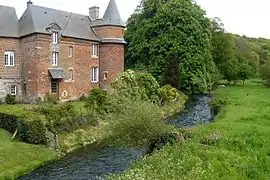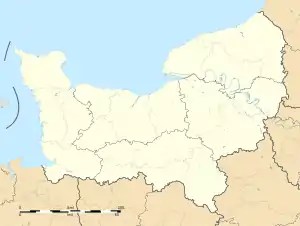Biville-la-Rivière | |
|---|---|
 The River Saâne in Biville-la-Rivière | |
Location of Biville-la-Rivière | |
 Biville-la-Rivière  Biville-la-Rivière | |
| Coordinates: 49°46′36″N 0°55′51″E / 49.7767°N 0.9308°E | |
| Country | France |
| Region | Normandy |
| Department | Seine-Maritime |
| Arrondissement | Dieppe |
| Canton | Luneray |
| Intercommunality | CC Terroir de Caux |
| Government | |
| • Mayor (2020–2026) | Franck Héricher[1] |
| Area 1 | 2.22 km2 (0.86 sq mi) |
| Population | 104 |
| • Density | 47/km2 (120/sq mi) |
| Time zone | UTC+01:00 (CET) |
| • Summer (DST) | UTC+02:00 (CEST) |
| INSEE/Postal code | 76097 /76730 |
| Elevation | 47–128 m (154–420 ft) (avg. 65 m or 213 ft) |
| 1 French Land Register data, which excludes lakes, ponds, glaciers > 1 km2 (0.386 sq mi or 247 acres) and river estuaries. | |
Biville-la-Rivière (French pronunciation: [bivil la ʁivjɛʁ]) is a commune in the Seine-Maritime department in the Normandy region in northern France.
Geography
A small farming village in the Pays de Caux, situated by the banks of the Saâne river, some 14 miles (23 km) southwest of Dieppe, near the junction of the D107 and the D2 roads.
Population
| Year | Pop. | ±% p.a. |
|---|---|---|
| 1968 | 124 | — |
| 1975 | 113 | −1.32% |
| 1982 | 102 | −1.45% |
| 1990 | 98 | −0.50% |
| 1999 | 107 | +0.98% |
| 2007 | 106 | −0.12% |
| 2012 | 105 | −0.19% |
| 2017 | 106 | +0.19% |
| Source: INSEE[3] | ||
Places of interest
- The church of St.Pierre, dating from the eighteenth century.
See also
References
- ↑ "Répertoire national des élus: les maires" (in French). data.gouv.fr, Plateforme ouverte des données publiques françaises. 13 September 2022.
- ↑ "Populations légales 2021". The National Institute of Statistics and Economic Studies. 28 December 2023.
- ↑ Population en historique depuis 1968, INSEE
Wikimedia Commons has media related to Biville-la-Rivière.
This article is issued from Wikipedia. The text is licensed under Creative Commons - Attribution - Sharealike. Additional terms may apply for the media files.